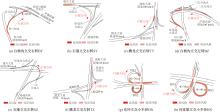| [1] |
中国公路学会编委会. 交通工程手册[M]. 北京: 人民交通出版社,1998:43-52.
|
| [2] |
裴玉龙, 程国柱. 高速公路车速离散性与交通事故的关系及车速管理研究[J]. 中国公路学报, 2004, 17(1):74-78.
|
|
PEI Yulong, CHENG Guozhu. Research on the relationship between discrete character of speed and traffic accident and speed management of freeway[J]. Chinese Journal of Highway and Transport, 2004, 17(1): 74-78.
|
| [3] |
杨迪, 徐进, 吕能超, 等. 山地城市立交出入口驾驶员心理负荷研究[J]. 中国科技论文, 2022, 17(2):195-202.
|
|
YANG Di, XU Jin, LYU Nengchao, et al. Mental workload of drivers at interchanges in mountain cities[J]. China Sciencepaper, 2022, 17 (2): 195-202.
|
| [4] |
郭玉洁, 郭唐仪, 吴军. 基于因子分析的城市隧道驾驶人心理负荷变化规律[J]. 交通运输研究, 2021, 7(2):91-99.
|
|
GUO Yujie, GUO Tangyi, WU Jun. Change regularity of drivers' psychological load in urban tunnels based on factor analysis[J]. Transportation Research, 2021, 7 (2): 91-99.
|
| [5] |
徐进, 刘小明, 胡静. 基于自然驾驶数据的螺旋匝道(桥)驾驶人心理负荷分析[J]. 交通运输系统工程与信息, 2020, 20(3): 212-218.
|
|
XU Jin, LIU Xiaoming, HU Jing. Analysis of driver mental load on helical ramps and helical bridges based on naturalistic driving data[J]. Journal of Transportation System Engineering and Information Technology, 2020, 20 (3): 212-218.
|
| [6] |
张雪榆, 潘存书, 林伟, 等. 山地城市多车道交织区驾驶人心理负荷研究[J]. 中国安全科学学报, 2022, 32(3):25-32.
doi: 10.16265/j.cnki.issn1003-3033.2022.03.004
|
|
ZHANG Xueyu, PAN Cunshu, LIN Wei, et al. Psychological load of drivers in multi-lane interweaving areas of urban roads[J]. China Safety Science Journal, 2022, 32 (3): 25-32.
doi: 10.16265/j.cnki.issn1003-3033.2022.03.004
|
| [7] |
徐进, 陈正欢, 廖祺硕, 等. 基于心电数据的高速公路高密度互通立交驾驶负荷研究[J]. 吉林大学学报:工学版, 2024, 54(10):2807-2817.
|
|
XU Jin, CHEN Zhenghuan, LIAO Qishuo, et al. Mental workload of drivers at high-density interchanges of freeways based on ECG data [J ]. Journal of Jilin University: Engineering and Technology Edition, 2024, 54(10):2807-2817.
|
| [8] |
陈正欢. 高密度互通立交驾驶人精神负荷与安全风险研究[D]. 重庆: 重庆交通大学, 2023.
|
|
CHEN Zhenghuan. Study on driver's mental workload and safety risks of high-density interchanges[D]. Chongqing: Chongqing Jiaotong University, 2023.
|
| [9] |
GE Hongcheng, HE Shijian, SUN Yuhai, et al. A method for evaluating the safety of freeway tunnel sections based on driving comfort: a naturalistic driving study[J]. Traffic Injury Prevention, 2023, 24(8): 670-677.
|
| [10] |
BEINUM A, FARAH H, WEGMAN F, et al. Driving behaviour at motorway ramps and weaving segments based on empirical trajectory data[J]. Transportation Research Part C: Emerging Technologies, 2018, 92: 426-441.
|
| [11] |
徐进, 孙子秋, 冯忠祥, 等. 互通立交直连式右转匝道小客车运行特性[J]. 中国科技论文, 2022, 17(8): 844-850.
|
|
XU Jin, SUN Ziqiu, FENG Zhongxiang, et al. Driving behavior of passenger car on direct-connected right-turn ramp of interchange[J]. China Sciencepaper, 2022, 17 (8): 844-850.
|
| [12] |
WANG Xiaofei, DING Zhenzhong, GUO Kai, et al. A simulation-based comprehensive analysis for traffic efficiency and spatial distribution of risks in short weaving area of municipal interchange[J]. Journal of Advanced Transportation, 2021, 2021: 1-14.
|
| [13] |
张晖, 刘永杰, 吴超仲, 等. 考虑行车安全事件严重程度和个体差异的驾驶行为风险评估[J]. 中国安全科学学报, 2023, 33(7):24-31.
doi: 10.16265/j.cnki.issn1003-3033.2023.07.1120
|
|
ZHANG Hui, LIU Yongjie, WU Chaozhong, et al. A risk assessment method of driving behavior considering severity of safety-critical events and individual heterogeneity[J]. China Safety Science Journal, 2023, 33 (7): 24-31.
doi: 10.16265/j.cnki.issn1003-3033.2023.07.1120
|
| [14] |
丁瑞, 刘俊, 蒋艳, 等. 基于车辆加速度数据的互通立交匝道驾驶风险分析[J]. 交通信息与安全, 2021, 39(1):17-25.
|
|
DING Rui, LIU Jun, JIANG Yan, et al. Driving risks of interchange ramps based on vehicle acceleration data[J]. Journal of Transport Information and Safety, 2021, 39 (1): 17-25.
|
| [15] |
FENG Zhongxiang, YANG Miaomiao, ZHANG Weihua, et al. Effect of longitudinal slope of urban underpass tunnels on drivers' heart rate and speed: a study based on a real vehicle experiment[J]. Tunnelling and Underground Space Technology, 2018, 81:147-153.
|
| [16] |
张敏, 陈嘉乐, 张驰, 等. 基于航拍数据的高速公路出口环圈匝道行车安全性评价方法[J]. 长安大学学报:自然科学版, 2024, 44(4):108-118.
|
|
ZHANG Min, CHEN Jiale, ZHANG Chi, et al. Aerial photography data-based method for evaluating traffic safety of highway exit loop ramps[J]. Journal of Chang 'an University:Natural Science Edition, 2024, 44 (4): 108-118.
|
| [17] |
沈海旭. 多车道高速公路分流影响区通行能力分析[D]. 西安: 长安大学, 2021.
|
|
SHEN Haixu. Analysis on traffic capacity of diversion affected area of multi-lane highway[D]. Xi 'an: Chang 'an University, 2021.
|

















